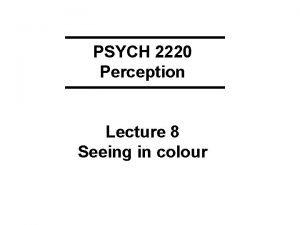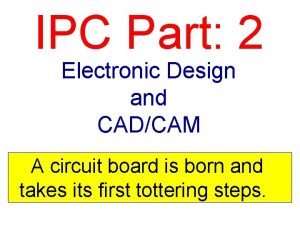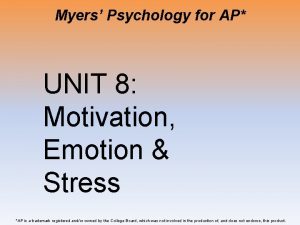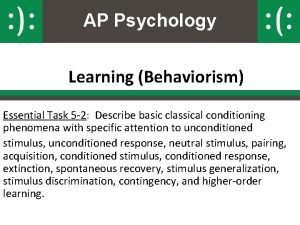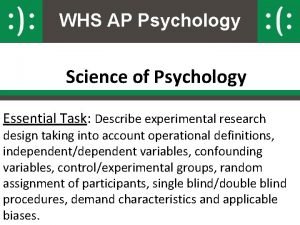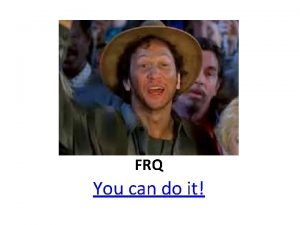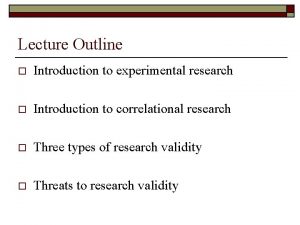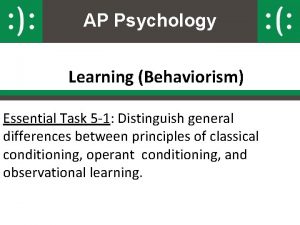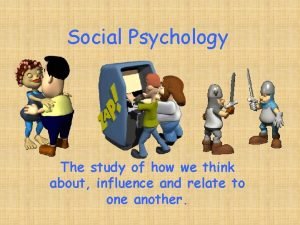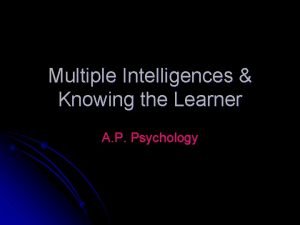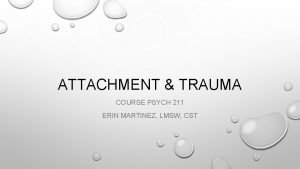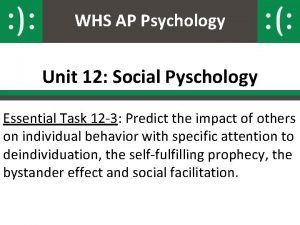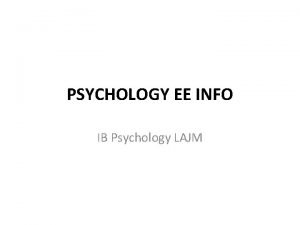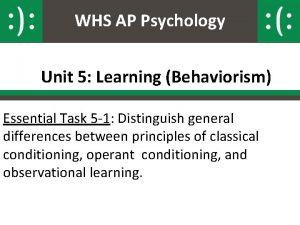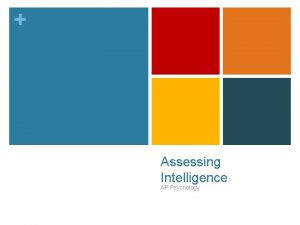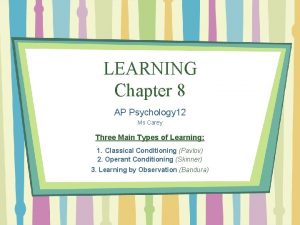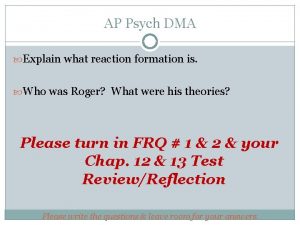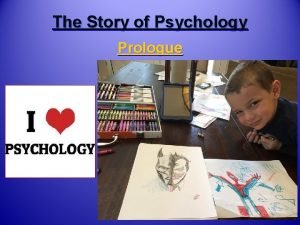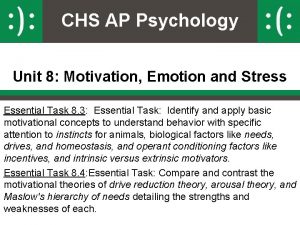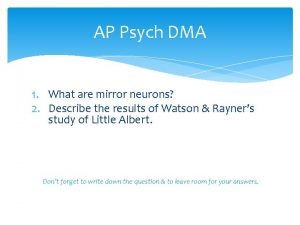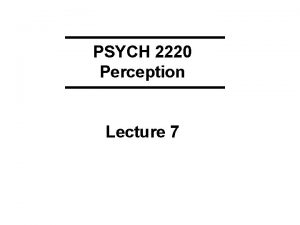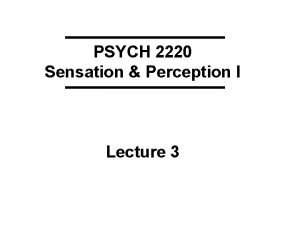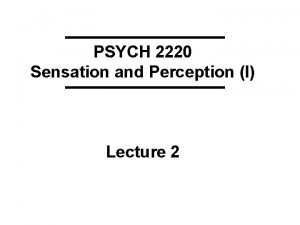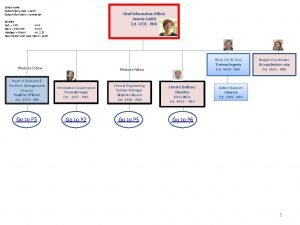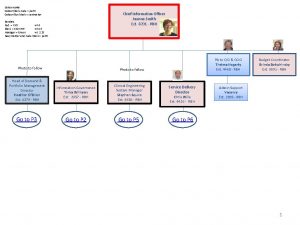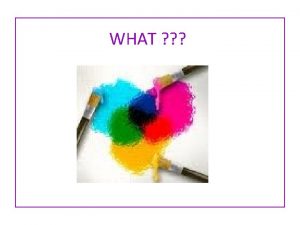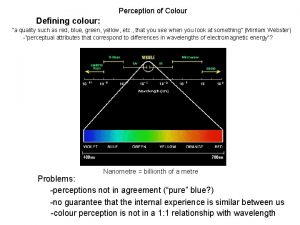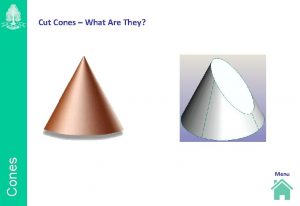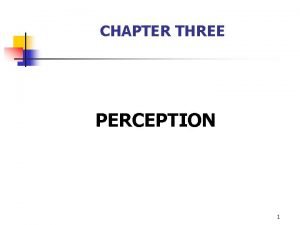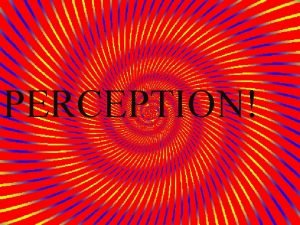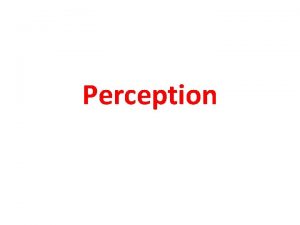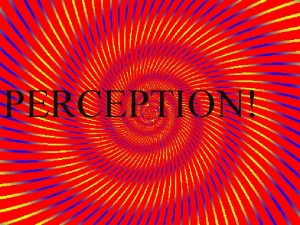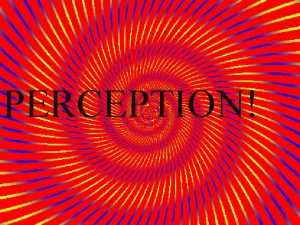PSYCH 2220 Perception Lecture 9 COLOUR Trichromacy cones



















































- Slides: 51

PSYCH 2220 Perception Lecture 9

COLOUR Trichromacy cones, three photopigments, long wavelength, medium wavelength, short wavelength, colour matching, 'normal' need three lights, colour blindness Opponency adaptation, colour after-effect, lateral inhibition (at level of retinal ganglion cells)

VISUAL ILLUSIONS A classification system: 1 Adaptation illusions 2 Simulation illusions 3 Incompatible cue illusions 4 Geometric illusions

VISUAL ILLUSIONS A classification system: 1 Adaptation illusions 2 Simulation illusions 3 Incompatible cue illusions 4 Geometric illusions

VISUAL ILLUSIONS A classification system: 1 Adaptation illusions 2 Simulation illusions 3 Incompatible cue illusions 4 Geometric illusions

VISUAL ILLUSIONS A classification system: 1 Adaptation illusions 2 Simulation illusions 3 Incompatible cue illusions 4 Geometric illusions

Müller-Lyer Illusion

BOTTOM UP…. TOP DOWN ….

BOTTOM UP 1 eye movements 2 limited acuity 3 physiological confusion

response level cells in a hypercolumn minding their own business

response level when a bar comes on they give a response…

response level But the cells are wired together with INHIBITORY connections

response level so highly active cells inhibit their neighbours the most

response level which releases the higher-firing cells from inhibition and makes them fire more, bringing out the signal better

response level Now we add some other lines. .

response level Which activate the cells tuned to those orientations…

response level Which pulls down the response of the vertically tuned cell

A physiological confusion explanation for the Müller-Lyer

BOTTOM UP 1 eye movements 2 limited acuity 3 physiological confusion TOP DOWN 1 empathy 2 “good figure” 3 perspective



small thing close big thing far EMMERT’s LAW If retinal image stays the same then perceived size will depend on distance








The Thatcher Illusion


Do we need to LEARN to see?


EMPIRICIST (all knowledge comes from experience) NATIVIST (knowledge is ‘a priori’; you are born with it)

EVIDENCE 1 Animal behaviour 2 Blind people recovering their sight 3 Babies’ visual development 4 Adaptation experiments 5 Controlled rearing experiments

1 animal behaviour

Molyneux’s question: “could a man born blind distinguish a sphere and a cube by sight alone? ” 2 blind people recovering sight





3 child development, Fant’z Experiment




4 adaptation

4 adaptation

5 controlled rearing

Blakemore video about development

EVIDENCE Animal behavour …………. Nativist Blind people recovering their sight… Empiricist & nativist Babies’ visual development …………. Empiricist & nativist Adaptation experiments …………… Empiricist Controlled rearing experiments ………. . Empiricist

 Ap psych sensation and perception
Ap psych sensation and perception Hft 2220
Hft 2220 Seeing 2220
Seeing 2220 Ipc-2251
Ipc-2251 01:640:244 lecture notes - lecture 15: plat, idah, farad
01:640:244 lecture notes - lecture 15: plat, idah, farad Myers psychology unit 8
Myers psychology unit 8 Krisennetzwerk unterfranken
Krisennetzwerk unterfranken Behaviorism ap psych
Behaviorism ap psych Double blind procedure ap psychology
Double blind procedure ap psychology Rudolf skobe
Rudolf skobe Frq sodas
Frq sodas What is definition of terms in research example
What is definition of terms in research example Psych 270a
Psych 270a Behaviorism ap psych
Behaviorism ap psych Ap psychology thinking language and intelligence
Ap psychology thinking language and intelligence Aacandautism
Aacandautism Assimilation ap psychology
Assimilation ap psychology Social trap example
Social trap example Psych 105
Psych 105 Belief perseverance ap psychology example
Belief perseverance ap psychology example Shaping adalah
Shaping adalah Cognitive dissonance ap psychology
Cognitive dissonance ap psychology Hot cold empathy gap
Hot cold empathy gap Behavior geneticists ap psych
Behavior geneticists ap psych Bodily kinesthetic intelligence
Bodily kinesthetic intelligence Classical conditioning
Classical conditioning Antisocial personality disorder ap psychology definition
Antisocial personality disorder ap psychology definition Apicatt
Apicatt Psych 211
Psych 211 Near-death experiences are ap psych
Near-death experiences are ap psych Ap psych schema
Ap psych schema Superordinate goals psychology definition
Superordinate goals psychology definition Social loafing ap psychology definition
Social loafing ap psychology definition Ucf online psychology degree
Ucf online psychology degree Ee in psychology
Ee in psychology Operant conditioning ap psychology definition
Operant conditioning ap psychology definition Proximodistal development
Proximodistal development Alfred binet ap psychology
Alfred binet ap psychology Mse assessment
Mse assessment Ms carey ap psych
Ms carey ap psych Edo psych
Edo psych Brain lateralization refers to the ap psych
Brain lateralization refers to the ap psych Lazarus ap psych
Lazarus ap psych Cand. psych
Cand. psych Reaction formation psych
Reaction formation psych What is habituation in psychology
What is habituation in psychology Psychology memes
Psychology memes Intelligence testing
Intelligence testing Instinct ap psych definition
Instinct ap psych definition Mse psych
Mse psych Prototype in psychology
Prototype in psychology Mirror neurons ap psych
Mirror neurons ap psych


